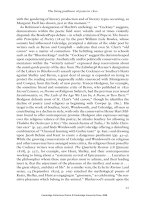The cambridge companion to british roman 45
Bạn đang xem bản rút gọn của tài liệu. Xem và tải ngay bản đầy đủ của tài liệu tại đây (39.08 KB, 1 trang )
The living pantheon of poets in 1820
with the gendering of literary production and of literary types occurring, as
Margaret Ezell has shown, just at this moment.19
As Robinson’s designation of Hazlitt’s anthology as “Cockney” suggests,
demarcations within the poetic field were volatile and at times violently
disputed: the Bowles/Pope debate – in which criticism of Pope in The Invariable Principles of Poetry (1819) by the poet William Lisle Bowles, whose
sonnets had influenced Coleridge, prompted a defense of the older poet by
writers such as Byron and Campbell – indicates that even St. Clair’s “old
canon” was a matter of contention. The belittling names given to schools
such as the “Bluestockings” and the “Cockneys” suggest the derision heaped
upon experimental poetry. Aesthetically and/or politically conservative commentators within the “writerly nation” expressed deep reservations about
the avant-garde poetry of the day: from The Edinburgh Review’s denigration
of the Lakers to Blackwood’s assault upon the Cockneys or Southey’s blasts
against Shelley and Byron, a great deal of energy is expended on trying to
protect the reading nation, supposedly safely ensconced with Montgomery
and Cowper, from this body of new poetry. Francis Hodgson, for example,
the sometime friend and sometime critic of Byron, who published in 1820
Sacred Leisure; or, Poems on Religious Subjects, had the previous year issued
Sæculomastix; or, The Lash of the Age We Live In; A Poem, in Two Parts.20
Hodgson defends most of St. Clair’s “old canon,” though he identifies the
decline of poetry (and religion) as beginning with Cowper (p. 78n.). His
target is the work of Southey, Scott, Wordsworth, and Coleridge, all seen as
contributing to a decline in style, with only the conservative Henry Hart Milman found to offer contemporary promise. Hodgson also expresses outrage
over the religious valence of this poetry; he attacks Southey for allowing in
Thalaba the Destroyer (1801) “the moral charms of Turks, / To tickle Christian ears” (p. 39), and finds Wordsworth and Coleridge offering a disturbing
combination of “Classical learning with Gothic taste” (p. 89n.) and drawing
upon Jacob Behme and Kant to create a dangerous pantheism (pp. 43–4).
While the growing conservatism of Coleridge and Wordsworth on religious
and other issues may have assuaged some critics, the religious threat posed by
the Cockney writers was often noted. The Quarterly Review (18 [January
1818], p. 327), for example, saw Hunt, Shelley, and their contemporaries
working to bring about a “systematic revival of Epicureanis . . . Lucretius is
the philosopher whom these men profess most to admire, and their leading
tenet is, that the enjoyment of the pleasures of the intellect and sense is . . .
the great object, and duty of life”. In a similar vein, the Eclectic Review (2nd
series, 14 [September 1820], p. 169) attacked the mythological poems of
Keats, Shelley, and Hunt as engaging in “grossness,” as celebrating “the sensitive pleasures which belong to the animal.” Blackwood’s assault upon the
23
Cambridge Collections Online © Cambridge University Press, 2008
